This site contains affiliate links. As an Amazon Associate, I earn a commission from qualifying purchases at no extra cost to you. Full Disclosure Here.
The shape of your blade is one of the main contributors to how your knife will behave as you use it. As you read through our guide, you’ll notice that specific knife blade shapes will excel in a specific area while they may sacrifice performance in another. This is life in the knife world and along with every choice you make in the buying process, whether that’s blade shape or the steel it’s made out of, you’ll be making sacrifices for performance according to your own specific situation.
Knives are tools and tools are crafted with respect to answering a problem. No knife manufacturer on the planet assumes a carpenter is going to wield the same knife as a paratrooper. That said, there are some blade shapes that are more versatile than others and in this guide, we’ll talk about exactly which knife blade types are best for your use cases and the pros and cons of each blade shape.
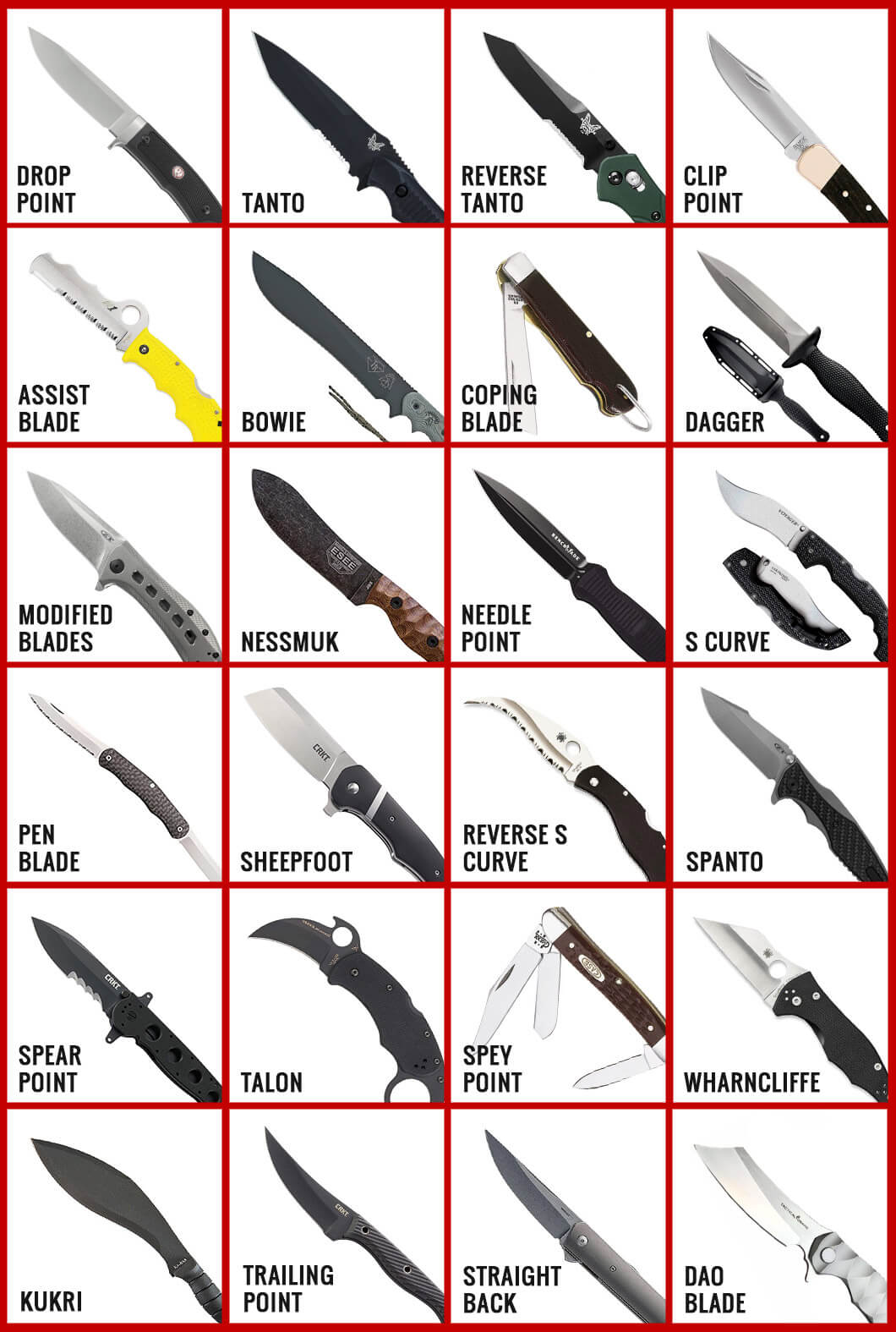
There really is no best blade shape and as such, the shapes at the top of our list are not necessarily better or worse than the blade shapes at the bottom. If you have any questions or special experience with knives, feel free to share with us in the comment section below!
Keep in mind that manufacturers often attempt to change the game and catch the attention of new blade seekers and as such, we won’t be able to review each and every blade shape that is or will be created in the future but more so we will discuss the most important and popular blade shapes to date. If we miss one, shout out in the comments and we’ll add it to the list as soon as possible.
Each of the following will have an example of a knife that utilizes the blade shape mentioned above. These are simply knives that we like and are using them as real examples and by no means are we trying to convey that these recommendations are the best knives using that blade shape as that is totally subjective and dependent on your use case. After learning about the different blade types below, you might also want to check out our in-depth guide on knife blade steels here. We also have reviews on our favorite fixed blade knives, EDC knives, self defense knives, and combat knives that I think you’ll find useful.
That’s okay, be confused, buy a few, try a few, decide what you like! Choosing a blade is an important choice, just like your significant other, and you wouldn’t want to do it blindly, so here at Marine Approved we’ve deployed a rather heavy-duty guide on knife blade shapes to get you headed in the right direction.
In this guide, we’ll discuss why it’s important to be educated on the shape of your blade and then we’ll go through the plethora of options with a thorough discussion that should help you decide which blade shape fits the tasks you face. Not all knives are created equally and not all knives will perform equally in all situations and thus it’s important that you kick back, relax, and ponder rigorously on what challenges your future sharp and pointy companion will likely endure.
The shape of the blade your knife comes with is an extremely important factor in how well the knife will behave and perform when faced with certain tasks but it’s only one factor of many. Other attributes of blades to consider are the steel it’s forged out of, the grind it’s been given, the moving parts such as the lock and opening mechanisms, and the handles!
Here is a List of Knife Blade Types and Shapes
1. Drop Point (Most Popular and Versatile)
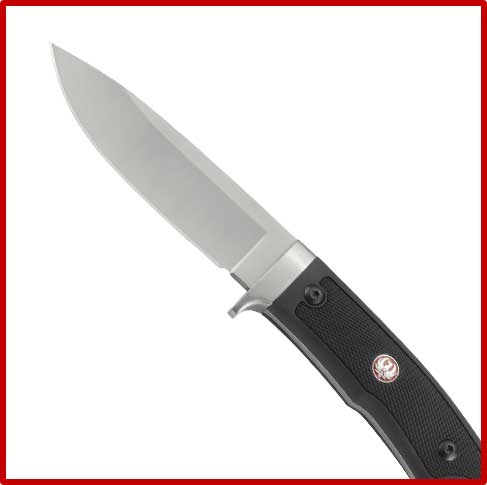
Description: The drop-point is by far the most popular blade shape today and that’s due to a simple and versatile design. This blade features a gradually sloping spine that ensures the point is centered on the axis line. The belly of the blade begins somewhat flat but also gradually slopes up exponentially until it meets the point.
Common Use Cases: Drop-points are useful for just about everything. These are commonly carried as EDC pocket knives but are found among a wide user base for many different applications. The tight point makes thrusting and stabbing quite effective and the long gradually upward sloping belly is excellent for sawing, cutting, slashing, etc and since the spine isn’t normally sharpened, the spine is typically extra thick which increases the strength of the blade.
The drop-point can often be found with serrated or partially serrated blades and some designers get funky by adding features along the spine, like sawteeth or short serrated sections. The number of variations the drop-point can be found in makes these knives a fit for just about anyone.
Drawbacks: While the drop point isn’t the best for every task it doesn’t have any serious drawbacks that come to mind since they are so versatile and found in so many variations. I guess I would choose something else, like the Tanto blade if self-defense or combat was your sole use case for the knife as there are better blades for that, and the clip-point moves through tight spaces a bit better but that really comes down to personal preference.
| Shape Stats | Score |
| Popularity | 10 out of 10 |
| User Friendliness | 10 out of 10 |
| Versatility | 10 out of 10 |
| Self Defense | 7 out of 10 |
| Tactical | 8 out of 10 |
| Bushcraft | 8 out of 10 |
Example Knife: A Marine Approved recommendation for a knife utilizing a drop point shaped blade is the Benchmade Bugout 535.
2. Tanto
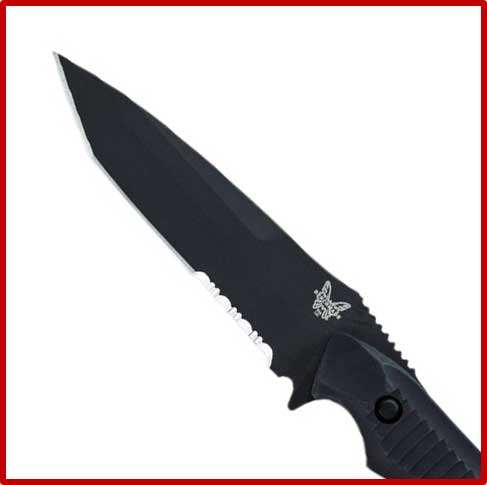
Description: The Tanto blade with its rather high positioned reinforced point and flat grind has become extremely popular, especially in the Western world due to its effectiveness in combat and deadly appearance. The point is especially strong due to the geometry of the angle under the point and thus making the Tanto one of the best penetrating blades that remains user-friendly. These points are so strong that a well made decent-sized Tanto blade can pierce body armor quite easily.
Usefulness as a daily use knife? Eh, it’s not great but if you like the design and you also carry a knife you want to utilize in a self-defense situation, the Tanto might just be right for you. The reason a Tanto blade lacks in day-to-day normal usage is due to the cutting edge being really flat with no curved belly, making the total cutting area of the blade much less than an equally as long drop-point blade.
US vs JP Tantos: The US version of the Tanto came much later than the Japanese version and features a much stronger point with that notorious flat-faced cutting edge on the bottom near the tip. The Japanese version has a slightly curved cutting edge where that flat section is on the US version giving it a bit more versatility and better piercing capability.
Common Use Cases: Combat and where excellent piercing capability is needed. Many people will EDC a Tanto because it looks cool, offers exceptional self-defense, and can be used for many tasks despite not being as versatile as something like a clip or drop point blade.
Drawbacks: Lacks versatility compared to the clip or drop point blade shapes.
| Shape Stats | Score |
| Popularity | 6 out of 10 |
| User Friendliness | 5 out of 10 |
| Versatility | 6 out of 10 |
| Self Defense | 8 out of 10 |
| Tactical | 8 out of 10 |
| Bushcraft | 5 out of 10 |
Example Knife: A Marine Approved recommendation for a knife utilizing a Tanto shape blade is the Benchmade Nimravus 141.
3. Reverse Tanto
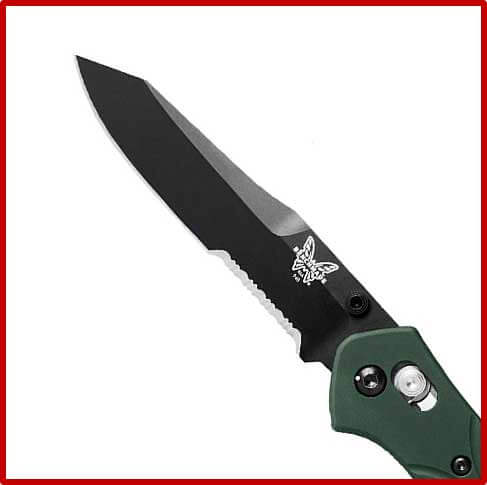
Description: These are actually relatively new compared to many of the shapes on this list and, as the name reads, is a Tanto flipped upside down. An excellent Benchmade designer named Warren Osborne made these especially popular among premium EDC enthusiasts. Some reverse Tantos can be a little different from his designs though such as the design of Bob Dozier, who designed a blade that has a more curved belly like a drop-point but has that harsh slope on the end of the spine.
Either way, reverse Tanto blades really only have one major difference from the regular Tanto blade and that is the top of the spine having that harsh usually flat but angled drop off to the point. This makes the blade tip easier to work through tight spaces as the point is a bit thinner overall. One last comment here is that the Dozier design sets the point lower in relation to the midpoint than a spearpoint does, trading off some of its belly length for perhaps better tip control.
Common Use Cases: I think these are designed mostly just to appear different than other knives on the market. Both versions of the Reverse Tanto offer great versatility for EDC applications and with the extra material gone from the spine near the tip, these blades offer pinpoint tip control when maneuvering through touch or thick material.
Drawbacks: The tip of the blade won’t be nearly as rigid and strong as a traditional drop-point and thus isn’t as versatile and tough overall. You’re trading off strength at the tip for a thinner more controllable experience.
| Shape Stats | Score |
| Popularity | 1 out of 10 |
| User Friendliness | 8 out of 10 |
| Versatility | 7 out of 10 |
| Self Defense | 7 out of 10 |
| Tactical | 7 out of 10 |
| Bushcraft | 7 out of 10 |
Example Knife: A Marine Approved recommendation for a knife utilizing a reversed tanto shaped blade is the Benchmade EDC 940.
4. Clip Point
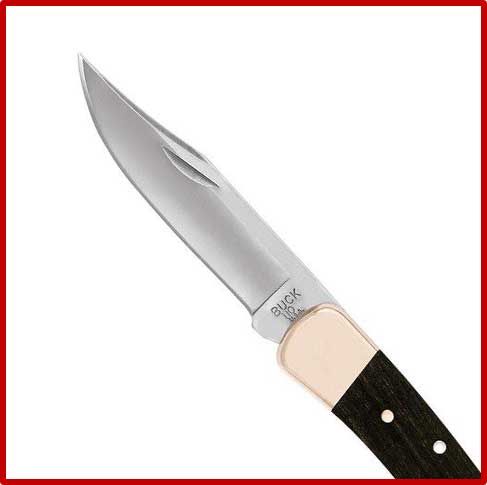
Description: The clip-point blade type is extremely popular and well-known due to its simplicity, versatility, and classical heritage. Bowie knives were based on this design and for good reason, the clip point style blade features a very long cutting surface with a belly that juts out straight for a nice straight edge but then trails upward to a tight point at the end. Clip-point blades generally have an unsharpened spine that, just like the belly of the knife, begins to appear straight and flat, but towards the point, it immediately drops into a convex curve such as it would look if you cut it with nail clippers.
Modern iterations of the clip point design can include a more straight area where the convex curve would be almost appearing to look like a reverse tanto. Furthermore, some manufacturers sharpen the clip-point on both the belly and the curve on the spine, making these useful for cutting rope, wire, and fishing line.
Common Use Cases: Clip-points encompass the Bowie, so technically these have a long history of combat use cases but the clip-point blade is extremely versatile and is useful for just about anything. This style of blade also truly excels at bushcraft and whittling. These are some of the most common blade shapes due to their ease of use and versatility.
Drawbacks: Clip-points aren’t generally used on tactical style knives so that may be a drawback if you want that tactical feel.
| Shape Stats | Score |
| Popularity | 10 out of 10 |
| User Friendliness | 10 out of 10 |
| Versatility | 9 out of 10 |
| Self Defense | 8 out of 10 |
| Tactical | 5 out of 10 |
| Bushcraft | 9 out of 10 |
Example Knife: A Marine Approved recommendation for a knife utilizing a clip point blade is the Buck Knives 110.
5. S Curve
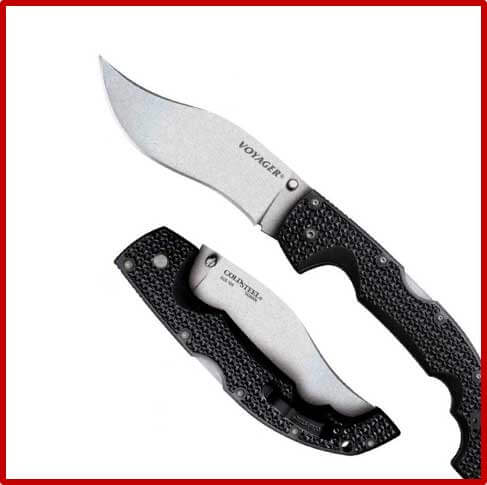
Description: As opposed to the Reverse S curve, the S curve can be identified when the point of the blade is facing upwards. This creates a wide belly excellent for slashing but lacks versatility and user-friendliness found on more traditional shapes like the drop-point.
Common Use Cases: Some people may use this for self-defense for the excellent slashing effect but in all reality, this is more of a blade shape for those looking at something unique and abnormal.
Drawbacks: Not very user-friendly nor versatile. This blade shape sometimes makes the blade feel like it has the performance of a much shorter blade.
| Shape Stats | Score |
| Popularity | 1 out of 10 |
| User Friendliness | 1 out of 10 |
| Versatility | 2 out of 10 |
| Self Defense | 6 out of 10 |
| Tactical | 5 out of 10 |
| Bushcraft | 3 out of 10 |
Example Knife: A Marine Approved recommendation for a knife utilizing an S curve shaped blade is the Cold Steel Voyager.
6. Reverse S Curve
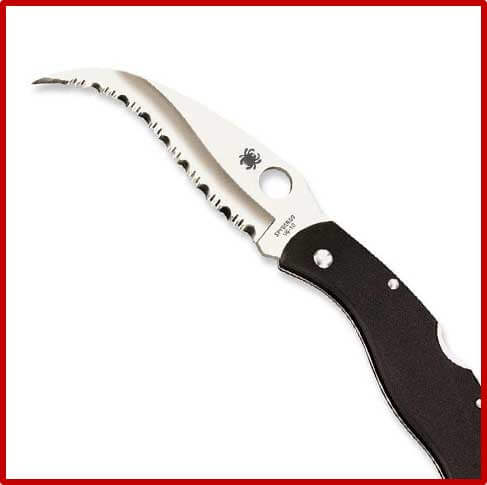
Description: These are certainly not very popular knife shapes to come across but you’ll notice immediately when a knife has a Reverse S or S curved blade. On the Reverse S version, you’ll see the typical shape of an “S” with the point of the knife facing downwards.
Both S style blades suffer greatly in versatility and user-friendliness. These blade shapes are primarily designed to try and add more cutting surface to curved objects and make thin and shallow slices. In a more deadly situation, the Reverse S blade allows the tip to slash deeply into the object and then pulls the belly of the blade further into the target as the slash continues, causing significantly more damage without the need to apply forward motion to the slash motion itself.
If you think about it, the Reverse S kind of incorporates a Hawkbill at the end of the knife and of course that comes with the uses and advantages of a Hawkbill but further down is a belly with a nice cutting edge that otherwise wouldn’t be present on a Hawkbill.
Common Use Cases: Specialized cutting on curved objects or similar attributes of the Hawkbill.
Drawbacks: Not nearly as easy or friendly to use as a more traditional blade shape and suffers from some lack of blade rigidity.
| Shape Stats | Score |
| Popularity | 1 out of 10 |
| User Friendliness | 1 out of 10 |
| Versatility | 3 out of 10 |
| Self Defense | 7 out of 10 |
| Tactical | 6 out of 10 |
| Bushcraft | 3 out of 10 |
Example Knife: A Marine Approved recommendation for a knife utilizing a reversed S curve shaped blade is the Spyderco Civilian.
7. Trailing Point (AKA Skinner, Upward Curve, or Upswept)
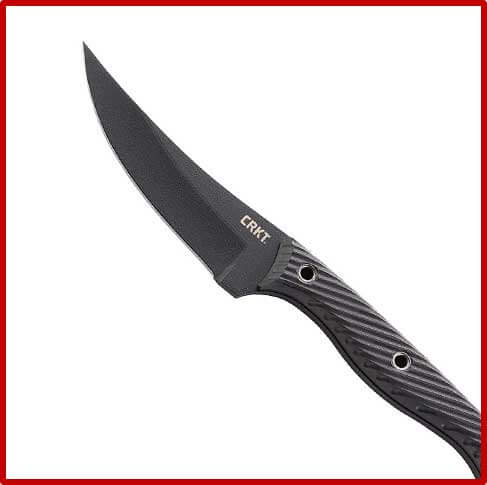
Description: The purpose of a trailing point is to create a large amount of cutting surface using an upswept belly. This creates a very long cutting edge in a shorter overall package length and is especially useful for skinning and slicing. Although most popular in food preparation, some people use these to clean fish or field dress their hunt. Fillet knives are also classified as trailing point blades.
Common Use Cases: Filleting, food preparation, general usage, etc. The trailing point is a very versatile utility blade that offers exceptional cutting length along its upswept belly. The point is not very strong but this is the tradeoff of having a very long and easy to use cutting edge.
Drawbacks: As mentioned before, the point lacks the strength to be used as a piercing blade to tradeoff for that long and handy cutting edge along the belly.
| Shape Stats | Score |
| Popularity | 8 out of 10 |
| User Friendliness | 8 out of 10 |
| Versatility | 4 out of 10 |
| Self Defense | 3 out of 10 |
| Tactical | 3 out of 10 |
| Bushcraft | 2 out of 10 |
Example Knife: A Marine Approved recommendation for a knife utilizing a trailing point shaped blade is the CRKT Clever Girl.
8. Straight Back (AKA Standard or Normal)
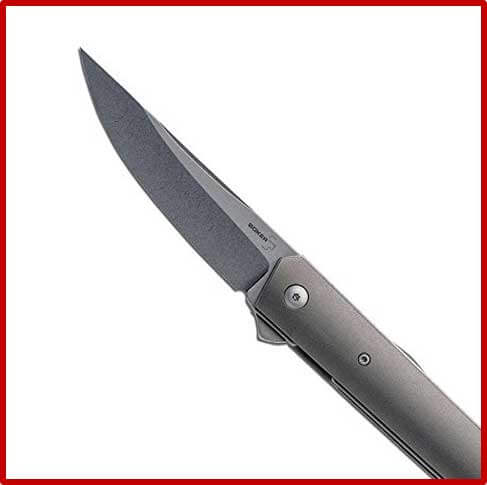
Description: A very common and straight forward blade shape is the straight back and just as the name suggests, the spine is perfectly straight from the handle to the tip and the belly is mostly flat until curving up to the point. The point of a straight back will always be level with the top of the handle. This blade shape can be used across many use cases as its versatility almost rivals the drop-point.
Common Use Cases: One big reason to grab a straight back blade is for the option to firmly press with your hand on the spine of the blade. These blades can also be made to be very thick, tough, and heavy, capable of chopping wood or hacking your way through dense foliage. Straight back blades have been used in combat applications as well and of course, could be used for self-defense purposes.
Drawbacks: Compared to the superbly versatile drop-point, you lose some of the cutting edge the belly has to offer by forcing the belly to meet the tip all the way at the top of the spine.
| Shape Stats | Score |
| Popularity | 7 out of 10 |
| User Friendliness | 8 out of 10 |
| Versatility | 8 out of 10 |
| Self Defense | 9 out of 10 |
| Tactical | 8 out of 10 |
| Bushcraft | 8 out of 10 |
Example Knife: A Marine Approved recommendation for a knife utilizing a standard-shaped blade is the Boker Plus Kwaiken.
9. Assist Blade
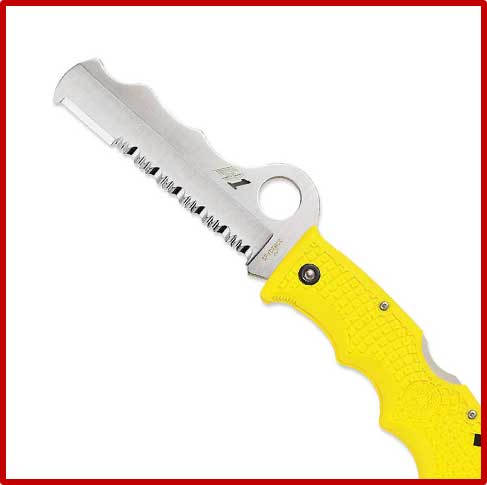
Description: The assist blade shape is notorious for its blunted tip, ensuring the blade cannot penetrate. These are excellent blades to have with you when fishing or cutting rope, seatbelts, clothing, etc due to being able to saw effectively while being safe from accidental stabbing.
Common Use Cases: Commonly found on emergency seatbelt cutters or being used by commercial fishermen.
Drawbacks: Having a blunted tip means this blade will have absolutely no penetration capabilities and would not fare well being used for self-defense. These blade shapes are not very commonly found by many brands, however, Spyderco has done an excellent job making a few great ones.
| Shape Stats | Score |
| Popularity | 2 out of 10 |
| User Friendliness | 10 out of 10 |
| Versatility | 3 out of 10 |
| Self Defense | 1 out of 10 |
| Tactical | 1 out of 10 |
| Bushcraft | 1 out of 10 |
Example Knife: A Marine Approved recommendation for a knife utilizing an assist style blade is the Spyderco Rescue Assist.
10. Bowie
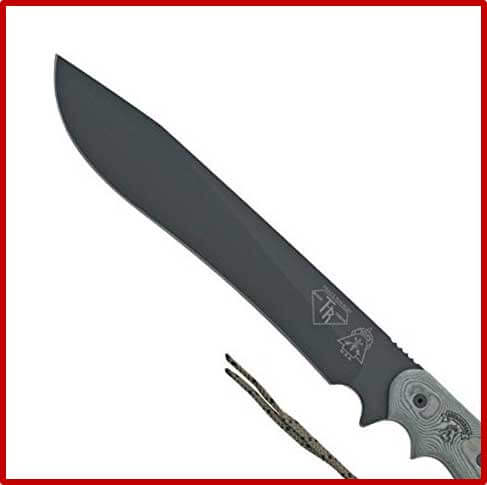
Description: Bowie’s have long been known and became popular in the 19th century when Jim Bowie gave a special request to a rather famous blacksmith (James Black) that detailed a long clip-point style blade with a hefty crossguard for protection in combat to be used in the Sandbar Fight duel. These blades, while known for a long history of combat, have many other uses too. Many outdoorsmen choose large Bowie style knives for cutting through dense foliage and as a large camp knife.
The Bowie knife has a very interesting heritage and history that you can find out more about this blade type here.
Common Use Cases: Notoriously combat but more so for camping and hiking nowadays. Anything would warrant a large sharp piece of steel being hacked and swung at something is generally something the Bowie knife would excel at.
Drawbacks: Bowie blades are typically long by nature meaning they aren’t fit for EDC or everyday use. Bowie blades are also very heavy and sometimes left behind on hiking trips for lighter and thinner blade types.
| Shape Stats | Score |
| Popularity | 10 out of 10 |
| User Friendliness | 4 out of 10 |
| Versatility | 7 out of 10 |
| Self Defense | 10 out of 10 |
| Tactical | 5 out of 10 |
| Bushcraft | 8 out of 10 |
Example Knife: A Marine Approved recommendation for a knife utilizing a Bowie-shaped blade is the Tops Knives Armageddon.
11. Coping
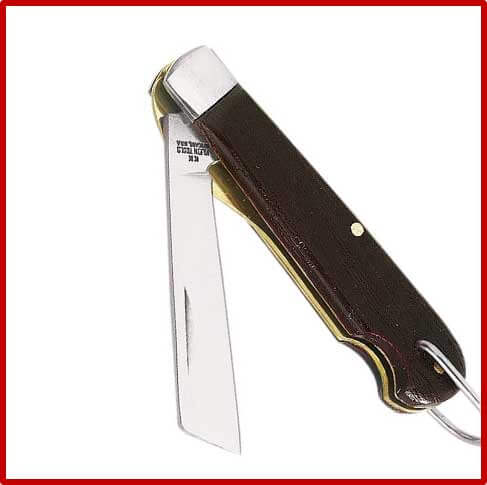
Description: The coping blade is quite similar to the Sheepfoot blade but instead of having a flat or rounded blunted point, it has a downward flat angle slope from the spine to the tip. The cutting edge is still flat from tip to grip, though, and the coping blade is used in a lot of the same ways you would use a Wharncliffe or Sheepfoot blade.
Common Use Cases: As a tool blade for when penetration or stabbing it to be avoided. The coping blade gives decent maneuverability through things like carpet or clothing without the point of the blade being overly exposed to what’s behind it.
Drawbacks: A major lack of utility and versatility due to very low stabbing and penetration capability and a lack of a curved cutting edge.
| Shape Stats | Score |
| Popularity | 1 out of 10 |
| User Friendliness | 5 out of 10 |
| Versatility | 1 out of 10 |
| Self Defense | 1 out of 10 |
| Tactical | 1 out of 10 |
| Bushcraft | 1 out of 10 |
Example Knife: A Marine Approved recommendation for a knife utilizing a Wharncliffe-shaped blade is the Klein Tools Pocket Knife 1550-11.
12. Dagger
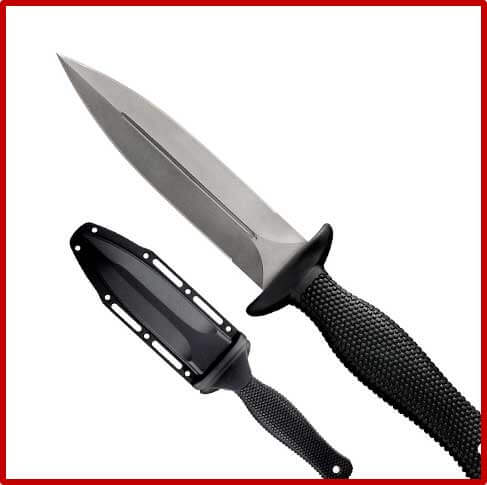
Description: Daggers are essentially spear-point blades resembling the Stiletto design that are much longer in length and generally thicker as well with a cross-guard. Basically, Daggers are purpose-built combat weapons that encompass the maximum wounding effect by utilizing a long and heavy double-edged blade that comes up to a very deadly point.
Some knives that appear to have the same shape and length but lack one side being sharpened to an edge are mistakenly labeled as daggers. This can be found in many knife laws as well, so do not assume that having one edge unsharpened disqualifies your blade from any dagger related legislation. Blades with only one edge but the same shape as a dagger are technically called thrusting knives. Thrust knives rely on the point to do the work and thus don’t really need sharp edges and as a result, gain more blade rigidity.
Common Use Cases: Long deadly blades meant for combat and self-defense. Commonly used as decorative showpieces.
Drawbacks: Daggers are not very user-friendly for day-to-day tasks and are illegal to own and/or carry in many places around the world, especially in the states.
| Shape Stats | Score |
| Popularity | 10 out of 10 |
| User Friendliness | 2 out of 10 |
| Versatility | 3 out of 10 |
| Self Defense | 10 out of 10 |
| Tactical | 8 out of 10 |
| Bushcraft | 3 out of 10 |
Example Knife: A Marine Approved recommendation for a knife utilizing a dagger-shaped blade is the Cold Steel Counter Tac One.
13. Dao Blade
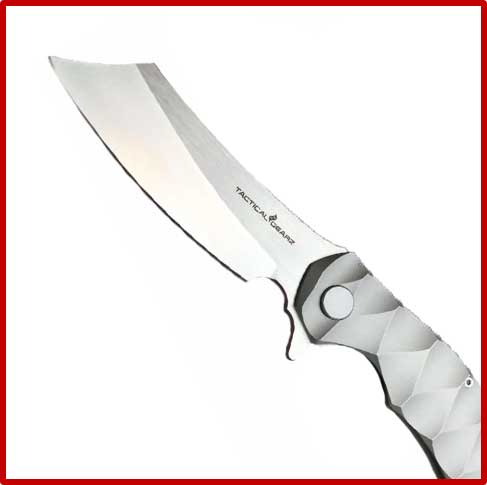
Description: Dao blades were traditionally used solely by the Chinese as single-edged short and long swords. These blade shapes consist of long and flat spines and bellies that, at the end near the point, encompass a thick tip. On the belly side of the tip, you get something resembling a drop point with its gradual upward curve to the tip. On the spine you see an upward curve that rounds out into the tip, giving the end of the sword a significant boost in weight and momentum when being swung.
These blades are obviously not EDC compatible in their original form but some manufacturers have changed things slightly to make them easier to use for regular tasks. Not many EDC or pocket knives come with these blades but if you do get a long blade it would be excellent for hacking through dense foliage.
By the way, these are actually pronounced with a “T” sound, like “Tau”.
Common Use Cases: Traditionally used as Chinese swords but now used mostly as showpieces.
Drawbacks: Extra weight at the end makes this sword style blade shape fatiguing to swing and not very agile.
| Shape Stats | Score |
| Popularity | 1 out of 10 |
| User Friendliness | 1 out of 10 |
| Versatility | 3 out of 10 |
| Self Defense | 9 out of 10 |
| Tactical | 3 out of 10 |
| Bushcraft | 4 out of 10 |
Example Knife: A Marine Approved recommendation for a knife utilizing a Dao shaped blade is the Tactical Gearz TG Zeus. This particular model is a very modern take on the original design.
14. Kukri
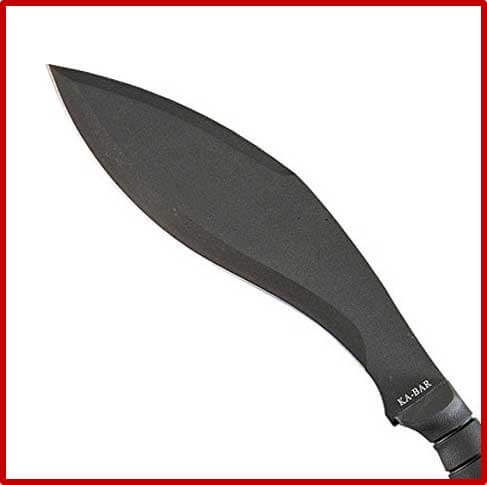
Description: This blade shape may seem quite alien to those of us living in the West but these are quite common on the Eastern side of the world as they were originally created by the Nepalese for farming and later used by armies in Asia as combat weapons. Now the Kurki blade is more of a novelty and showpiece than something a lot of people regularly use, however, people still do use them and they are quite handy for hacking through thick foliage or for some farming applications. I suppose you could keep a big old Kukri around for some good home-based self-defense applications as well!
These blades kind of look like super sharp boomerangs attached to a handle. The blade has a distinct recurve right in the middle of the belly with the spine also curving downwards towards the tip in relatively the same place as where the belly curves in.
Common Use Cases: Originally created for farming, hunting, and combat but now used for bushwacking.
Drawbacks: Not exactly something you would carry around with you on a daily basis and is often replaced by other blade styles for its primary uses. These are typically heavy and would require some serious practice to use effectively.
| Shape Stats | Score |
| Popularity | 4 out of 10 |
| User Friendliness | 2 out of 10 |
| Versatility | 3 out of 10 |
| Self Defense | 7 out of 10 |
| Tactical | 2 out of 10 |
| Bushcraft | 5 out of 10 |
Example Knife: A Marine Approved recommendation for a knife utilizing a Kukri shaped blade is the KA-BAR 1249-9 Kukri.
15. Leaf (Spyderco)
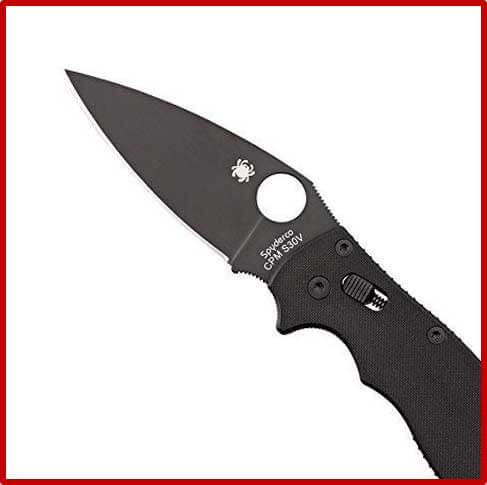
Description: A leaf style blade is basically a spear point in nature that got really fat and lost its spine edge. The spine and the belly are no longer perfectly symmetrical with the spine having more of an aggressive curve toward the point than the belly.
Spyderco designed this and utilizes it on a majority of their knives. I’m not sure what they were really going for, but the blade design certainly stands out and makes many of their knives unique. The blade shape is useful for a lot of things just like the drop-point and really offers the user a ton of versatility. While being extremely versatile, though, the blade doesn’t really excel notably at any one thing other than providing a good EDC that is easy to use across many applications. Overall, this is one of my favorite knife blade types for pocket knives.
Have you noticed that almost all Spyderco knives come with a hole? This article here by Spyderco explains their thought process behind this unique design.
Common Use Cases: Almost exclusively used by Spyderco for versatile EDC-style pocket knives.
Drawbacks: Leaf blades are highly versatile but aren’t the best choice if you have only one use-case in mind other than EDC usage.
| Shape Stats | Score |
| Popularity | 3 out of 10 |
| User Friendliness | 9 out of 10 |
| Versatility | 8 out of 10 |
| Self Defense | 7 out of 10 |
| Tactical | 6 out of 10 |
| Bushcraft | 6 out of 10 |
Example Knife: A Marine Approved recommendation for a knife utilizing a leaf-shaped blade is the Spyderco Dragonfly 2.
16. Modified Blades
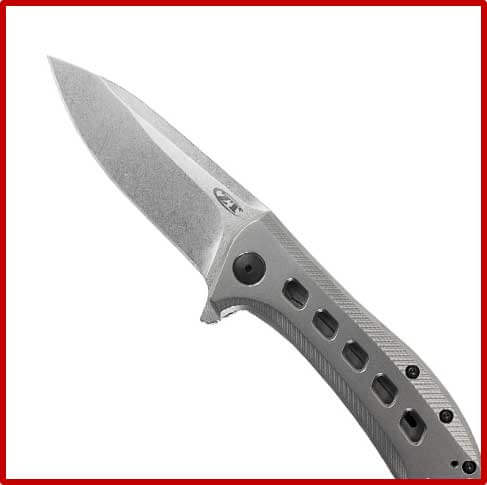
Description: A modified blade isn’t a shape itself but it is worth talking about as seeing the label “modified so and so” is becoming more and more popular as knife designers attempt to set their blades apart from the rest.
Modified blades are just blades that were modeled after another blade but modified in such a way that they no longer fit their original category. An excellent example of this would be the ZT Rexford KVT that is linked below. That knife has a drop-point style blade that has a more aggressive spine curve toward the point than you would normally expect to find on a standard drop-point blade.
Many blades may come as modified such as the Drop, Clip, Tanto, Sheepsfoot, Assist, Trailing, and more.
Common Use Cases: Either the blade was purpose-built for a specific task where it would excel with slightly different characteristics than the more popular blade shapes or the designer simply puts some flair into an existing blade shape to stand out and perhaps improve the design.
Drawbacks: The drawbacks would likely be similar to the base blade shape.
| Shape Stats | Score |
| Popularity | 2 out of 10 |
| User Friendliness | X out of 10 – Dependant on the shape |
| Versatility | X out of 10 – Dependant on the shape |
| Self Defense | X out of 10 – Dependant on the shape |
| Tactical | X out of 10 – Dependant on the shape |
| Bushcraft | X out of 10 – Dependant on the shape |
Example Knife: A Marine Approved recommendation for a knife utilizing a modified blade shape is the Zero Tolerance Rexford KVT.
17. Nessmuk
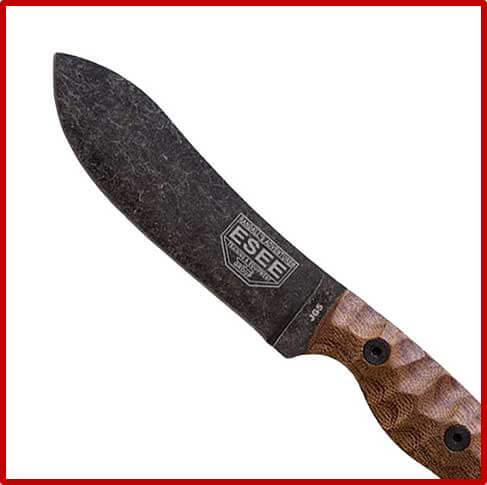
Description: While the official Nessmuk origin isn’t quite clear, the blade has been used by many different groups of people around the world and is hailed for its excellent slicing capability and performance in food preparation. It is rumored that a man in the mid-1800s named George Washington Sears specially requested the shape for his own personal use and since he was a known traveler and explorer, the knife shape was adopted by people he met along his excursions.
This blade shape is unique but does resemble a trailing or skinning style blade shape. The belly swoops upwards just like you would expect on a skinning blade but the spine is where the shape takes a different form. There is a large upward bump located near the point on the spine that I can only imagine simply adds weight to the end of the knife making it easier to slice through thick and heavy materials.
Common Use Cases: Bushwacking, food preparation, or skinning applications.
Drawbacks: Heavier than a similarly sized skinning knife, however, this may be an advantage too depending on what you need to use the knife for. These really aren’t very common and thus not many designs or manufacturers carry knives with this blade shape.
| Shape Stats | Score |
| Popularity | 1 out of 10 |
| User Friendliness | 5 out of 10 |
| Versatility | 4 out of 10 |
| Self Defense | 4 out of 10 |
| Tactical | 3 out of 10 |
| Bushcraft | 5 out of 10 |
Example Knife: A Marine Approved recommendation for a knife utilizing a Nessmuk shaped blade is the ESEE JG5.
18. Needle Point (AKA Stilleto)
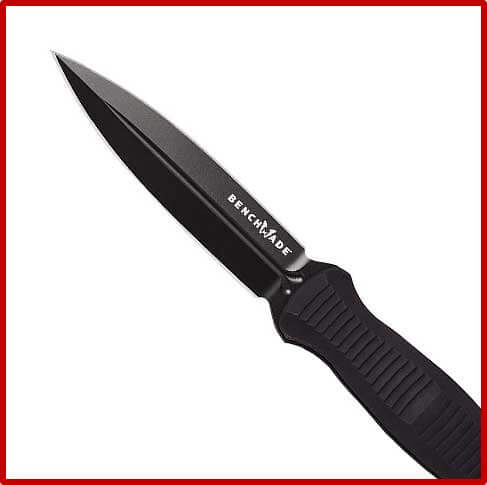
Description: These are technically part of the dagger family but are usually found in much smaller form factors than what most people would consider a technical dagger. Needle-point blades appear exactly as how they sound, the point comes to a sharp needle-like end while the blade itself is long and slender featuring double-edged sides.
This form factor is almost exclusively designed for thrusting and stabbing with its low surface friction point and thus are primarily used for combat or self-defense. It is not a very useful form factor for EDC, camping, hunting, etc and since both edges are generally sharpened, it’s hard to handle the knife and push through thick materials when sawing or cutting. Furthermore, these blades lack tensile strength since the edges are sharpened and there is no thick spine to support the blade.
Sometimes these blades can be found with one edge or even both edges unsharpened. These are technically called thrusting blades but you may find them mislabeled as needle or stiletto knives. The term “Stiletto” is Italian and technically the “Stiletto blade” was designed in Italy in the 15 century, however, it’s unclear whether there were other shortened double-edged blades used by other civilizations before that time period so we cannot conclude that Italians designed the first shortened daggers. These may also commonly be coined as switchblades and as such, can be illegal to own or carry in many places around the world.
Common Use Cases: Combat or self-defense. Otherwise used as show-pieces.
Drawbacks: Like daggers, these aren’t useful for much outside of combat or self-defense.
| Shape Stats | Score |
| Popularity | 4 out of 10 |
| User Friendliness | 2 out of 10 |
| Versatility | 2 out of 10 |
| Self Defense | 9 out of 10 |
| Tactical | 5 out of 10 |
| Bushcraft | 3 out of 10 |
Example Knife: A Marine Approved recommendation for a knife utilizing a needle point stiletto shaped blade is the Benchmade Infidel 133.
19. Pen Blade
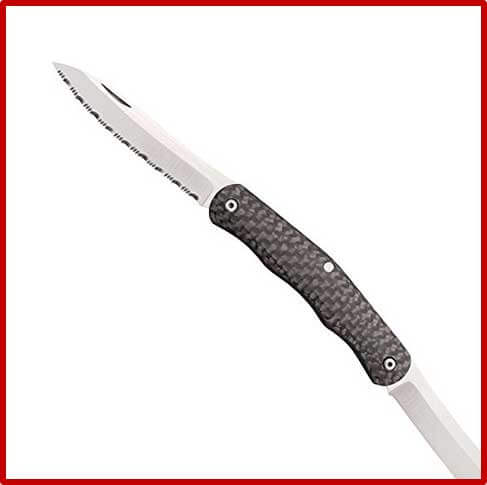
Description: The very term “Pen Blade” came about as a term referring to any extremely small pocket knife. Pen blades are almost always very slender and small blades shaped a lot like a tiny and slim drop-point, trailing knife, or scalpel type blade. There is no technical association between an actual pen that you would write with and a penknife.
Common Use Cases: Use as small EDC or for thinning and work on thin fabrics. Way back in the day, people carried pen knives to sharpen their pencils or to repair quills.
Drawbacks: Pen blades are typically very small and as such do not encompass a lot of strength or usable cutting surface. Multi-tools often encompass pen blades so you could argue that a multi-tool that is based around a pen blade is very useful and versatile but just a pen blade on its own lacks a whole lot of daily use versatility simply because it’s so small.
| Shape Stats | Score |
| Popularity | 7 out of 10 |
| User Friendliness | 7 out of 10 |
| Versatility | 3 out of 10 |
| Self Defense | 1 out of 10 |
| Tactical | 2 out of 10 |
| Bushcraft | 3 out of 10 |
Example Knife: A Marine Approved recommendation for a knife utilizing a pen blade is the Cold Steel Lucky.
20. Sheepfoot
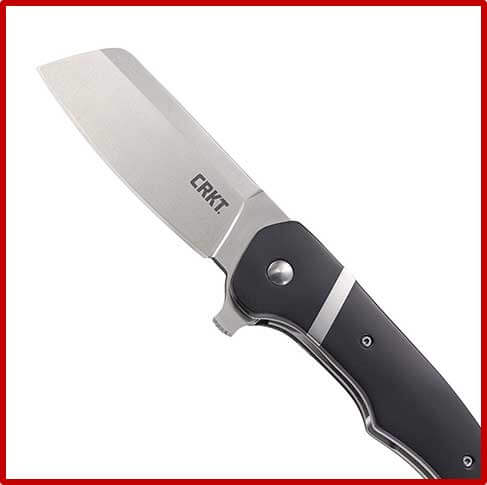
Description: The Sheepfoot is similar to the Assist style blade but usually comes with a more rounded off point than the Assist blades flat blunted tip. Both styles are ample for sawing and cutting where penetration would like to be avoided. These are excellent blades to use if your only task is sawing or cutting, for example, a commercial fisherman using a Sheepfoot blade exclusively to cut line and netting.
Common Use Cases: Any sawing or cutting applications where penetration of the tip is to be avoided.
Drawbacks: Having a rounded off point means no stabbing capabilities.
| Shape Stats | Score |
| Popularity | 2 out of 10 |
| User Friendliness | 8 out of 10 |
| Versatility | 4 out of 10 |
| Self Defense | 1 out of 10 |
| Tactical | 3 out of 10 |
| Bushcraft | 3 out of 10 |
Example Knife: A Marine Approved recommendation for a knife utilizing a Sheepsfoot shaped blade is the CRKT Ripsnort.
21. Spanto
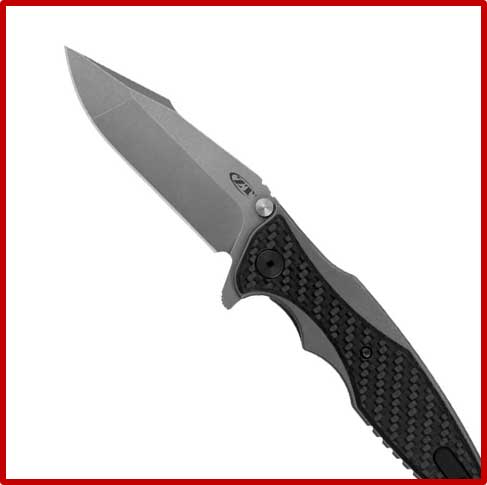
Description: Do you like the styling of a Tanto blade but refuse to give up the versatility from the ever so loved drop-point? Never fear, we now get to blend the two together! The Spanto will generally have a harsher curve than a drop-point but a curve nonetheless as opposed to the Tanto that meets the point after a flat and harsh upward turn. You still get the extremely sharp and tight point at the end but you also get more belly space for cutting and sawing.
By combining the drop-point and Tanto, you are basically making the ever so versatile drop-point slightly more deadly by making the point tighter and have less friction upon penetration.
Common Use Cases: Specially designed knives looking for a more aggressive style but still encompassing similar versatility to the drop-point. Basically, these are really cool looking EDC style blades that can be especially deadly if needed.
Drawbacks: Obviously there is more surface friction at the tip since the belly curves up instead of having a flat thin surface meet the point, so these aren’t as deadly as a Tanto but they certainly are more deadly than a drop-point with similar versatility. Since they aren’t tapered drastically, these don’t make for an optimum skinning experience.
| Shape Stats | Score |
| Popularity | 1 out of 10 |
| User Friendliness | 8 out of 10 |
| Versatility | 8 out of 10 |
| Self Defense | 8 out of 10 |
| Tactical | 8 out of 10 |
| Bushcraft | 7 out of 10 |
Example Knife: A Marine Approved recommendation for a knife utilizing a Spanto shaped blade is the Zero Tolerance Hinderer.
22. Spear Point (AKA Double Edged)
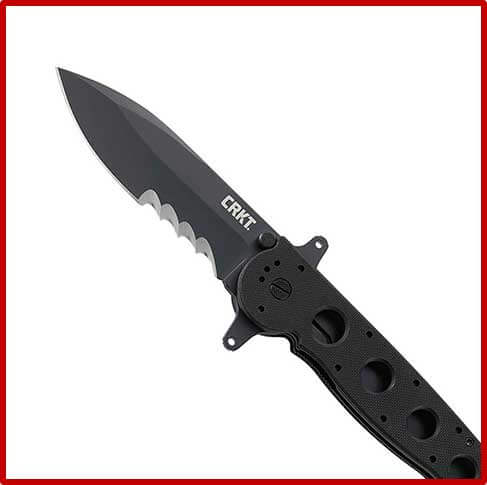
Description: Spear points are basically the same as the Stiletto and Needle Point but align the grind and bevel on the centerline of the blade which positions the point slightly lower than the axis, making the blade far more symmetrical. Spear points can be either double-edged or feature a false edge or swedge. This design creates a slightly easier to cut with belly and increases the strength of the point, making the knife a stronger and more durable weapon.
Common Use Cases: Many people think spear points are primarily made for combat and self-defense and while that is true in many cases, a good spear point blade can be incredibly useful across the board. Of course, if it’s double-edged you won’t be able to use your other hand as a guide but the spearpoint EDC knives that lack a double-edge are useful in many similar ways to the versatile Drop-Point or Spanto.
Drawbacks: Sacrifices some of the cutting edge along the belly to create a slim and lethal point.
| Shape Stats | Score |
| Popularity | 6 out of 10 |
| User Friendliness | 5 out of 10 |
| Versatility | 7 out of 10 |
| Self Defense | 8 out of 10 |
| Tactical | 7 out of 10 |
| Bushcraft | 5 out of 10 |
Example Knife: A Marine Approved recommendation for a knife utilizing a spear point shaped blade is the CRKT M21-14SFG.
23. Spey Point
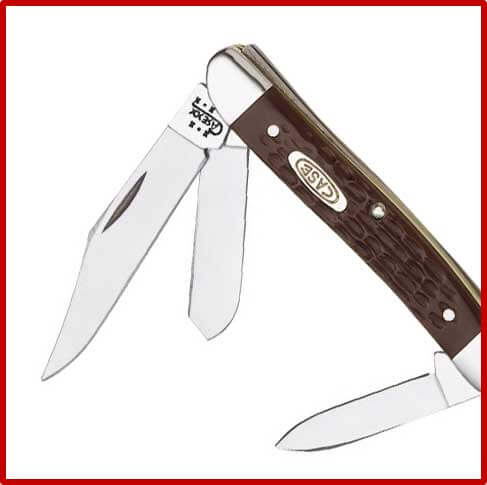
Description: The Spey blade shape is pretty much solely designed to cut through flesh with accuracy and maneuverability at the forefront of attention. Spey points are commonly used as a scalpel or speying tool.
The shape is kind of a reverse tanto with the top of the spine near the point being blunted and flat, moving the point really low along what otherwise could be called a drop-point style belly. This positioning of the tip allows for minimal penetration capability while keeping the tip low and easy to move through flesh with the belly of the knife at an angle.
Common Use Cases: Speying or anything you would use a scalpel for.
Drawbacks: Really only designed to spey animals or use as a scalpel to cut flesh so versatility and overall tensile strength is low.
| Shape Stats | Score |
| Popularity | 2 out of 10 |
| User Friendliness | 6 out of 10 |
| Versatility | 4 out of 10 |
| Self Defense | 2 out of 10 |
| Tactical | 2 out of 10 |
| Bushcraft | 2 out of 10 |
Example Knife: A Marine Approved recommendation for a knife utilizing a Spey point shaped blade is the Case Stockman.
24. Gut Hook (Hunting and Fishing)
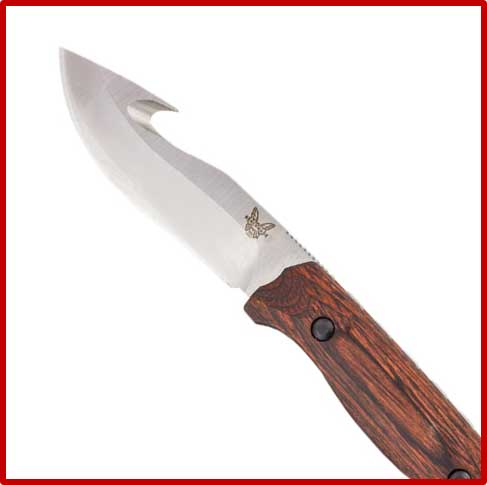
Description: A gut hook blade is a knife that features a hook on the spine near the point situated towards the handle. These hooks utilize a sharpened edge on the inside of the hook and are especially useful for slashing through fishing line, string, belts, or when field dressing your hunt.
Technically, the gut hook is more of a feature than a shape on its own. Typically, gut hook blades are in the shape of a trailing point, drop-point, or skinning knife.
Common Use Cases: Used almost exclusively by hunters and/or fishermen for field dressing or quickly cutting line.
Drawbacks: Many people buy these for the design and while it’s not bad to have the additional hook cutting edge available, if you don’t actually use it, it’s just wasted space and makes the spine harder to press down on if you’re cutting something really tough or thick. The hook can also get caught on things if cutting in tight spaces. Gut hooks aren’t usually available in folding knife configurations although you can find a few. This is is one of the best knife blade shapes for certain hunting and fishing applications.
| Shape Stats | Score |
| Popularity | 5 out of 10 |
| User Friendliness | 5 out of 10 |
| Versatility | 8 out of 10 |
| Self Defense | 6 out of 10 |
| Tactical | 4 out of 10 |
| Bushcraft | 4 out of 10 |
Example Knife: A Marine Approved recommendation for a knife utilizing a gut hook shaped blade is the Benchmade Saddle Mountain.
25. Talon (AKA Hawkbill or Karambit)
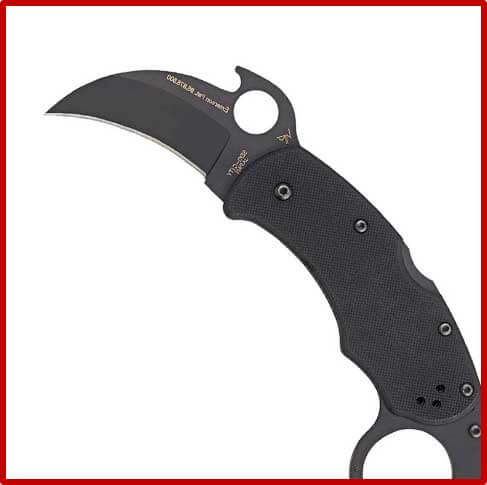
Description: Talon shaped blades encompass a spine and belly that curve in a concave fashion. Aside from looking awfully menacing, these are really only used for self-defense or activities that require a pulling motion such as cutting webbing or clothing.
The tiger claw inspired Karambit style was first developed by the Minangkabau in West Sumatra as a general-use tool to cut with a pulling motion in farming and textile work. As it spread out of Indonesia, it took a more lethal route, being used by people in combat.
People train for years to learn how to effectively use the Karambit in combat and/or self-defense. It can be very deadly but the Karambit is not user-friendly nor is it a good knife to utilize for someone inexperienced. If you are looking for a general self-defense solution, I would not recommend the Karambit unless you are willing to properly train with using this specific style.
Common Use Cases: Very popular in some Martial Arts. Used commonly for self-defense or use-cases in which a pulling motion is warranted. The tip of the blade is designed to slash while pulling the blade in deeper to cause more damage.
Drawbacks: Severely lacks versatility and utility and isn’t very effective for outward cutting as it would require you to angle your wrist outwards as you move away from your body, limiting your range of motion.
| Shape Stats | Score |
| Popularity | 6 out of 10 |
| User Friendliness | 1 out of 10 |
| Versatility | 2 out of 10 |
| Self Defense | 9 out of 10 |
| Tactical | 9 out of 10 |
| Bushcraft | 2 out of 10 |
Example Knife: A Marine Approved recommendation for a knife utilizing a hawkbill or talon shaped blade is the Spyderco Karahawk.
26. Wharncliffe
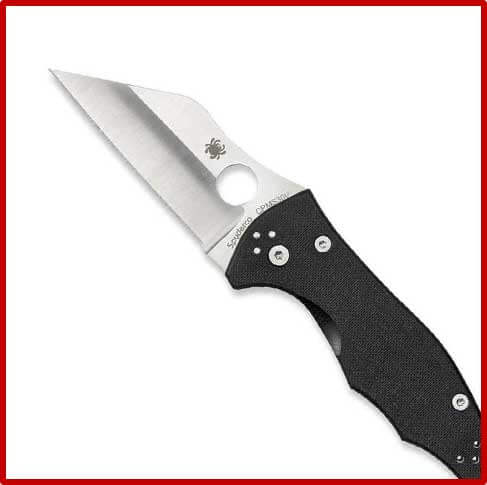
Description: Have you read our take on the straight back blade? If so, take that idea and flip it upside down and then sharpen the opposite side, now you have a Wharncliffe. The cutting edge is perfectly flat and sharp from tip to grip with a spine that begins flat from the grip but then slowly curves downwards into the tip.
Common Use Cases: This blade shape is especially useful for opening boxes or as a letter opener. This particular shape is difficult to cut soft tissue and as such may be a safer option to use in a warehouse or office when working in close quarters to other people.
Drawbacks: The obvious drawback here is the lack of curve along the belly and the point is basically useless.
| Shape Stats | Score |
| Popularity | 2 out of 10 |
| User Friendliness | 5 out of 10 |
| Versatility | 1 out of 10 |
| Self Defense | 1 out of 10 |
| Tactical | 1 out of 10 |
| Bushcraft | 1 out of 10 |
Example Knife: A Marine Approved recommendation for a knife utilizing a Wharncliffe shaped blade is the Spyderco Yojimbo 2.
Wrap Up
let us know in the comments section if you have any questions about knife blade shapes or you think there is anything we should add to this list. Feedback is always appreciated!

Good evening, Corporal Wabo! First of all, Thank You for your VERY informative series of web pages! As an outdoorsman for the past 50 plus years, I appreciate them and have them bookmarked.
A comment on your knife shapes page: I believe that the S-curved blade, ESPECIALLY in a serrated form, has been under-rated for self-defense. Not only do you have the ‘belly’ for a slashing attack, but the shape of the blade lines up the point with the handle for thrusting, which to my mind is preferable (if possible at the split-second that you need it).
Thus, you have several useful motions that you can make with it in quick succession. I have been considering this blade (in its serrated form) for several years now, evaluating the possibilities for defense; I finally “got off the pot” and purchased a serrated Cold Steel Voyager Vaquero this week and I’m not disappointed with the possibilities that it presents as a “social” knife.
If it were me, I’d rate this shape as a: 1/10 for popularity, 6 to 7/10 for user friendliness (in a defensive combat situation), keep it at a 2/10 for versatility (unless slashing and stabbing), 9 to 10/10 for self defense, and 2 to 3/10 for bushcraft.
Thanks Again for spreading your knowledge around!
The S Curve is also known as a recurve blade.